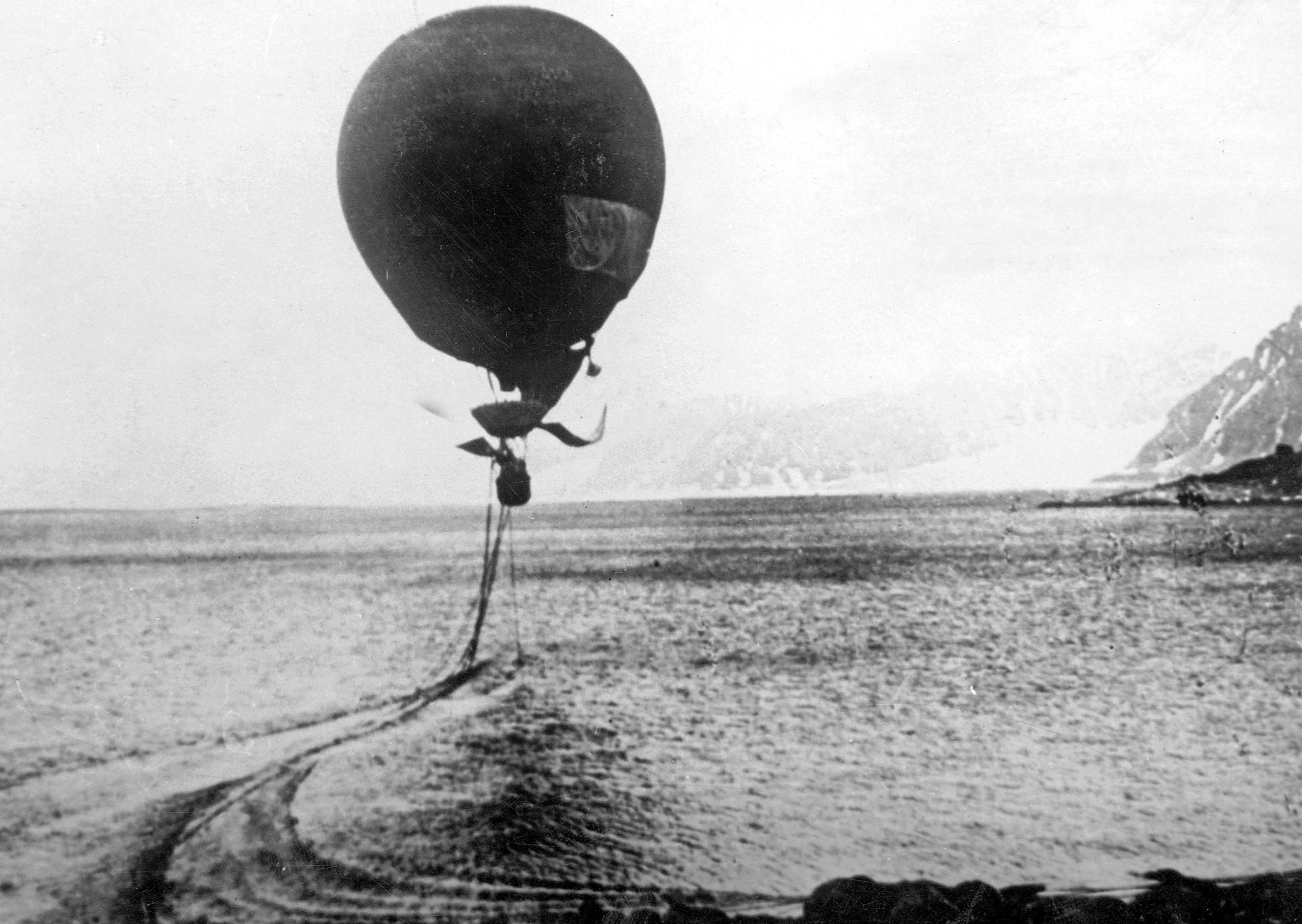In 1897, three Swedish aeronauts set out for the North Pole in a balloon, only to disappear in the vast Arctic. Their fate would remain a mystery for 33 years.
On February 15, 1895, Swedish engineer Salomon August Andrée announced his plans to conquer the North Pole. He boldly proclaimed that he would accomplish this not by sledge, since previous attempts by that method had failed, but by something else entirely. “Has not the time come to revise this question from the very beginning and to see if we do not possibly possess any other means than the sledge for crossing these tracks?” Andrée asked, then answered: “The means is the air balloon.”
Andrée outlined four conditions for success. One, the balloon must be able to carry three men and provisions. Two, it must be capable of remaining aloft for up to 30 days. Three, it would have to be filled with gas in the polar region. And four, he said, “The balloon must, to some degree, be dirigible.” To Andrée and other aeronauts of his day, the word “dirigible” meant the ability to steer through the air in the direction of intended travel, a feat that was not yet possible. But Andrée believed he had a solution to that problem: His polar balloon, he said, “shall be provided with a system of sails and with several drag—or guide—ropes.”
The notion that guide ropes could make a balloon steerable had come to him by accident on October 19, 1893, while he was aloft in his first balloon, the 37,230-cubic-foot Svea. An unexpected gust sent him clear across the Baltic Sea, and 10 hours later aeronaut and balloon landed hard on a lonely Finnish island 170 miles from where he had ascended. Andrée spent, as he put it, “an extremely unpleasant night” there before he was rescued the next day. That misadventure taught him something important. In an effort to slow the balloon as Svea initially hurtled out to sea, he had let his guide ropes float along the waves and discovered that this dragging effect kept the balloon moving in one direction—even if it was not necessarily the right direction.
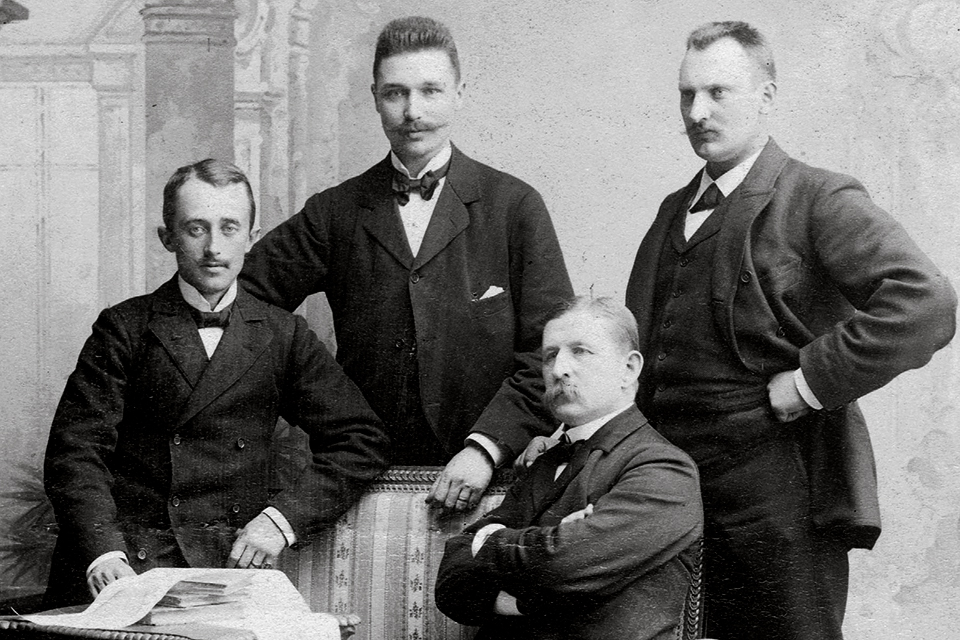
Andrée continued his trials with Svea, keeping a detailed diary of flights and making scientific observations at different heights of temperature, humidity, clouds and optical phenomena, as well his own thirst, facial color and respiration. (Among his more obscure discoveries: At 13,000 feet he could distinctly hear dogs barking on the ground.) After one flight he landed in the countryside and walked to a nearby building. There he found “a woman and a boy who had locked themselves in, and they did not dare to come out before they were quite assured that I was an ordinary man.” On other flights he tested his guide ropes for purposes of steering, along with a sail attached to the balloon for even more control.
Next Andrée began raising the considerable funds required for his aerial journey. He planned to waft himself and two companions from the Spitsbergen archipelago in the Arctic Circle to the North Pole and then, depending upon the winds, to either Alaska or Siberia. The goal was to make the journey in no more than six days. No one knew what discoveries awaited him over these forbidding regions, places not yet seen by human eyes. His audacious scheme bordered on madness—and Artic experts said so—but with backing from prominent individuals such as Alfred Nobel, the inventor of dynamite, and King Oscar II, sovereign of Sweden and Norway, Andrée raised all the money he needed. On the day before Christmas 1895, he signed a contract with Henri Lachambre of Paris to build a gigantic balloon.
In early June 1896, the freighter Virgo carried the polar expedition and its considerable gear to the icy waters around Spitsbergen. Andrée would command the flight, with Nils Ekholm, a meteorologist and astronomer, and Nils Strindberg, a physicist, serving as his two-man crew. After Virgo’s crew scouted the islands of Spitsbergen, Andrée chose a bay (soon named Virgo Harbor) on the north side of Danes Island as the expedition’s base. All the gear was unloaded, including the hydrogen gas apparatus, the balloon and the balloon’s tarpaulin-covered gondola, or “car,” and an immense six-story balloon shed was built. Then Andrée and his two companions patiently waited for a southerly wind to send them on their way. That wind never came, however, and on August 17, the short Arctic summer having ended, everyone headed back home aboard Virgo.
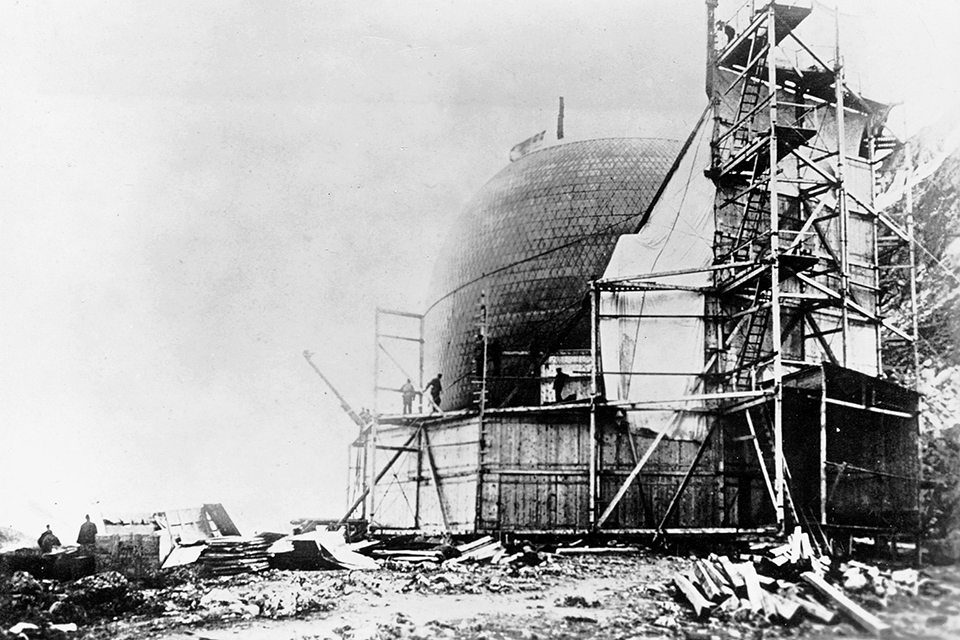
The following year the Swedish gunboat Svenksund accompanied Virgo back to the base on Danes Island, with both arriving on May 30, 1897. They were happy to see that their shed had survived the winter. By June 14, the balloon was positioned inside the structure, and three days later they inflated it with hydrogen gas, produced by pouring sulfuric acid over iron shavings.
It took many days to varnish the balloon and test it for leaks. A violent storm resulted in another delay. Finally, at 1:46 p.m. on July 11, Andrée cried, “Cut away everywhere!” and the freed balloon, christened Örnen (Eagle), rose and headed out to the northeast over Virgo Harbor, 200 to 300 feet above the waves.
Atop Örnen’s car stood Andrée, the old man of the expedition at 43, and his two young and fit colleagues, Strindberg, 25, and Knut Fraenkel, 27. Fraenkel was a replacement for Ekholm, who had lost his nerve for the flight in the intervening 12 months. Seconds after the balloon’s ascent, its sails unfurled to take advantage of the wind. All appeared normal until the balloon reached the middle of the harbor, where, caught in a sudden downdraft, it dipped down into the waves. Observers on the shore were horrified, but Örnen quickly rebounded high into the air and rotated completely around its vertical axis. The last the observers saw of the intrepid Swedes was Fraenkel climbing into the bearing ring under the hydrogen bag to remove the sails. Ten minutes later, the balloon flew over Holläner Naze, and after that reached the middle of Vogelsang Island at an altitude of about 2,000 feet. It then swung off to the east and disappeared in a cloud.
Back at the base, a sailor cried, “Look! The draglines are lying here on the shore!” That the draglines, necessary for dirigible flight, had somehow become detached from the balloon was potentially disastrous. But thanks to the discovery, years later, of diaries, letters and logbooks belonging to the trio, we know that the loss of the draglines (which were quickly replaced) and brief dunk in the harbor had barely fazed the men, and they never considered aborting their expedition.
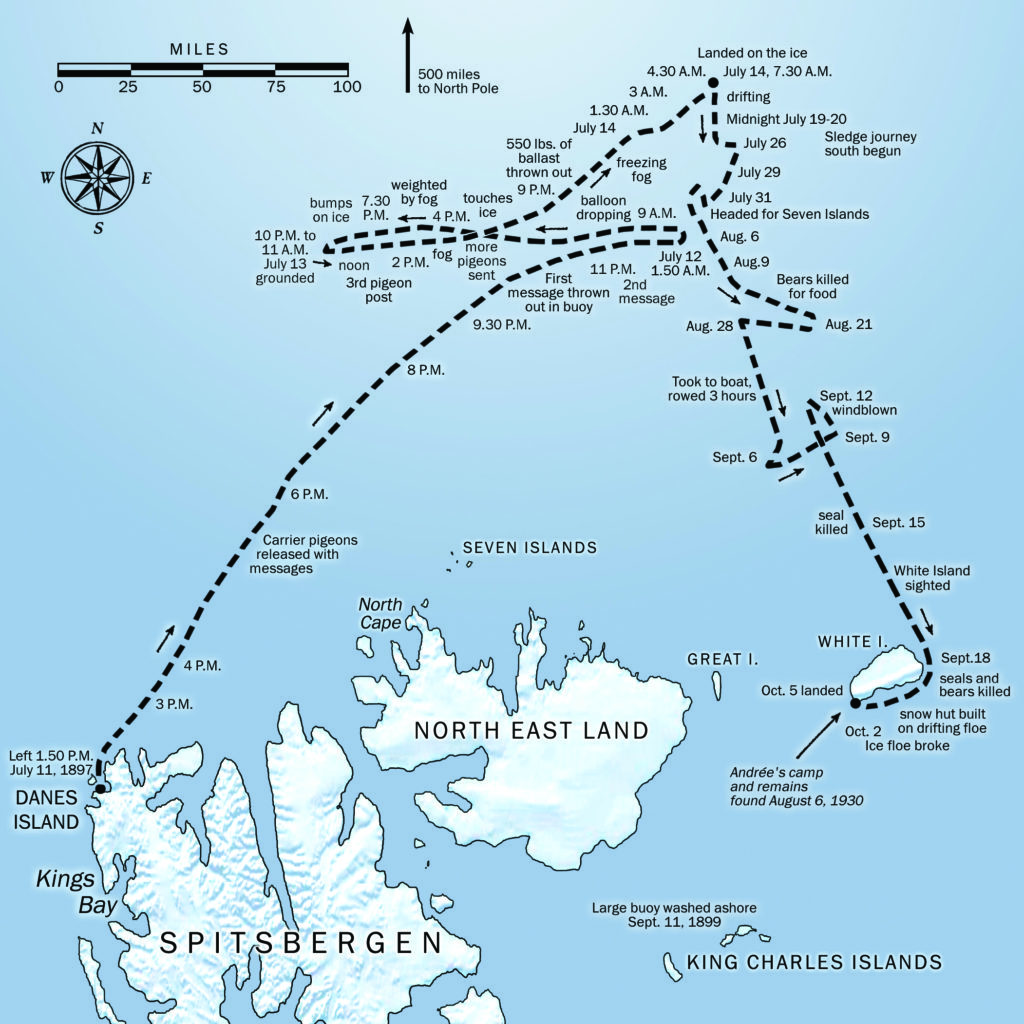
Of the many messages dispatched by the balloon crew during their odyssey, only three reached the outside world. The first, ironically, became the last one found, stuffed inside a cork buoy and discovered on the coast of Finmark, Norway, three years after its senders met their fate. Dated “July 11, 10 p.m.,” the note read in part, “Our journey has so far gone well….We are now in over the ice which is much broken up in all directions. Weather magnificent. In best of humors.” The second message turned up in Kollafjord, on the coast of Iceland, two years later. “This buoy,” it read, “is thrown out from Andrée’s balloon at 10.55 G.M.T. on July 11, 1897, in about 82º latitude and 25º long.” The third communication, dispatched via carrier pigeon, was received while the three men were still alive. The winged messenger, hungry and tired from more than 30 hours of flying, landed on the masthead of the Norwegian sealer Alken on July 15 and was promptly shot. Then, wondering whether the bird might have something to do with Andrée and his balloon, Alken’s captain turned his ship around and managed to retrieve the pigeon (now stuffed and in a museum). Inside its letter cylinder he found a brief note, giving no indication that the expedition might be in dire straits. Dated “July 13. 12.30 midday,” the dispatch related: “All well on board. This is the third pigeon-post. Andrée.”
Just minutes into the flight, high above Vogelsang Island, the temperature had registered 34 degrees, and Andrée estimated the balloon’s speed at 20 mph. Strindberg remembered a love letter he had written to his fiancée, and placing it in a tin, he tossed it down onto the island (where it remains to be found). Over the next 45 minutes the Swedes flew in and out of clouds, causing Örnen to alternately rise and descend, as the hydrogen expanded in the heat of the sun or contracted in the shade. While they were at 1,625 feet in blue skies, some 117 cubic feet of hydrogen escaped from the safety valve, an insignificant amount considering the size of the balloon’s 170,000-cubic-foot gasbag. Off the north point of Vogelsang, the crew enjoyed several bottles of ale.
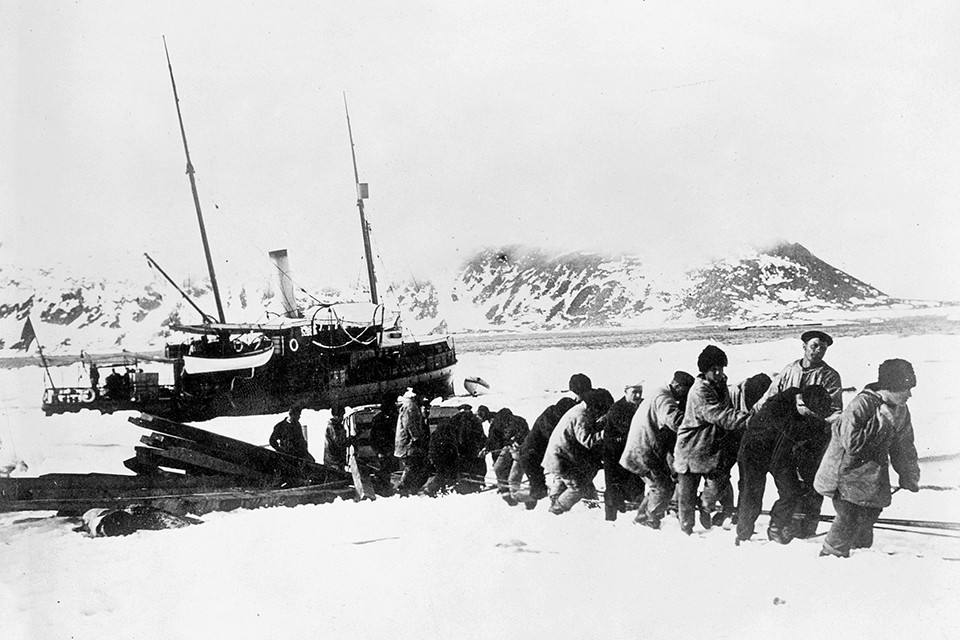
The altimeter read 1,600 feet, the wind was blowing south-southwest and drifting ice appeared to their north. While standing on the roof of the car, the balloonists had a magnificent view of Wijde Bay. Then, entering a light mist, they slowly descended in a winding curve to 780 feet, where they released four of the expedition’s 36 carrier pigeons. That first “pigeon-post” would vanish in the Arctic wastes.
With all going smoothly, Andrée put Strindberg in charge while he left the roof and squeezed himself into the car’s tiny compartment. He slept for several hours. Meanwhile the endless summer sunshine broke through the mist. Örnen rose to 1,950 and then 2,270 feet. Hydrogen, warmed by the sun, whistled softly out of the safety valve. After a few hours, the balloon passed beneath clouds and began losing altitude. In response, Strindberg dropped 18 pounds of sand. Shortly thereafter he sent the first buoy overboard, the one found three years later, which noted, “We are still moving at a height of 800 feet.” Eight minutes later Strindberg, still fighting for altitude, dumped more sand plus 11 rungs of the rope ladder. He also sent a second buoy overboard, reporting, “We are floating at a height of 600 feet.”
Then they approached an altocumulus cloud that was throwing a dark shadow over the ice. At 1:12 a.m. on July 12, Örnen entered its shadow at an altitude of 1,500 feet. In the next four minutes, they lost so much height that the dangling draglines touched the ice less than 400 feet below. “The sun has gone,” Strindberg wrote in his diary, “but we keep a very level course.” Fifty minutes later he dumped more sand, this time 26 pounds. Ominously, a solitary black bird appeared on the distant horizon and the wind died completely.
Andrée awoke at 2 a.m., and Strindberg and Fraenkel went below to rest. If Andrée had any concerns about the loss of altitude and ballast during his absence, he did not mention it. Instead he observed: “It is indeed a wonderful journey through the night. I am cold but will not wake the two sleepers. They need their rest.” The monotony of the next few hours was briefly broken when Andrée sighted a bearded seal and photographed it from a height of 50 or 60 feet. After Strindberg and Fraenkel awoke, the men prepared breakfast. They lowered a remote-controlled stove a safe distance from the potentially explosive hydrogen bag, and in 20 minutes were enjoying freshly brewed coffee.
By midday the three aeronauts had flown for nearly 24 hours. Later that afternoon, Strindberg reported seeing “Blood-red ice, perhaps a relic of a bear’s meal”—a reminder of the inhospitable world below.
A thick, cold fog had enveloped the aeronauts when, at 3:06 p.m., the balloon car “stamped” the ice. The startled balloonists instantly tried to climb to a sunnier altitude. Everything not urgently needed went overboard, including a buoy with a spring-loaded Swedish flag intended to mark the North Pole. But it made no difference. At that point the balloon was skimming so low above the ice that the car struck the surface hard several more times. Over the next six hours Andrée kept a meticulous record of the car’s bouncing trajectory. He recorded, for example, that at 5:14 p.m. there had been “8 ‘touches’ in 30 minutes,” and then an hour later “every five minutes,” and then “once every 500 feet,” until finally at “10.53 the balloon stopped.”
Everything dripped with cold moisture, and the men, hovering only a few feet above the ice, had no option but to wait out the fog. “Is it not a little strange to be floating here above the Polar Sea,” Andrée wrote philosophically, after telling Strindberg and Fraenkel to go to bed. “To be the first that have floated here in a balloon? How soon, I wonder, shall we have successors? Shall we be thought mad or will our example be followed? I cannot deny that all three of us are dominated by a feeling of pride. We think we can well face death, having done what we have done. Isn’t it all, perhaps, the expression of an extremely strong sense of individuality which cannot bear the thought of living and dying like a man in the ranks, forgotten by coming generations? Is this ambition?”
Strindberg took the next watch, and at 9:30 a.m. on July 13 the fog began to lift. An hour and a half later, after spending half a day on the ice, Örnen resumed flight. Another message was dispatched via pigeon post, and this time one of the pigeons got through (the one unlucky enough to reach Alken).
Shortly thereafter, though, the car resumed its horrible “stampings” along the ice. Desperate for some relief from these “heavy shocks,” Strindberg took refuge up in the balloon’s bearing ring, where he said he found “It confoundedly pleasant,” adding, “One feels so safe there and so at home.”
The early morning hours brought more fog and a new danger: heavy ice forming on the balloon ropes. The “touches, touches” came in quick succession, as the balloon dragged the car and its occupants over ice hummocks. Andrée suffered a blow to the head, something briefly caught fire and Strindberg vomited. Strindberg escaped to the bearing ring, this time followed by Fraenkel. At 8 p.m., the three aeronauts decided they must attempt to gain altitude at any cost, and within minutes 440 pounds of buoys, winches, sand, barrels and provisions lay scattered over the ice. Örnen then took to the air once more, its sails unfurled and its journey renewed. “The balloon goes extremely beautifully,” exalted Andrée. “Altogether it is quite stately!”
The airborne respite afforded the trio a chance to recuperate, but two hours later the fog returned and the car began striking the ice again. This continued throughout the early hours of July 14. The flight log captured little of this nightmarish period, but notations indicate that at the very end of the ordeal Örnen attempted one final dash to the heavens. The log read, “6.20, the balloon rose to a great height, but we opened both valves and were down again at 6.29.”
Andrée, Strindberg and Fraenkel stepped out onto the soft summer ice, their partially deflated balloon lying nearby like a beached whale. Örnen’s meandering flight had lasted 65 hours and 33 minutes, and covered many hundreds of miles. Now the three stranded aeronauts faced the daunting task of marching south, where they hoped to reach the easternmost islands of Spitsbergen, 200 miles away.
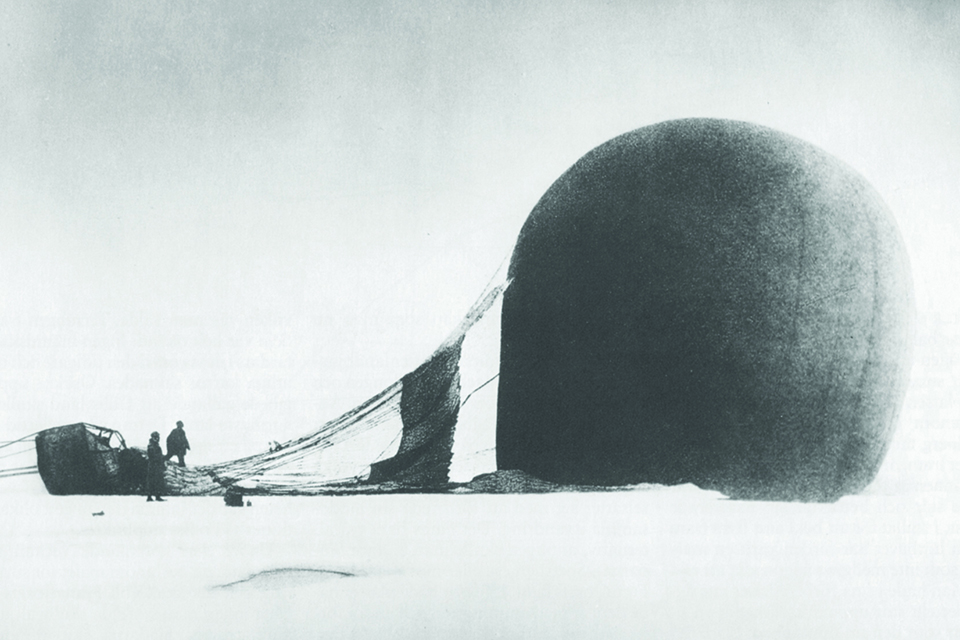
Meticulous as always, Andrée took his time packing and organizing three sledges and a canvas boat. They finally departed the landing site eight days later with an inordinate amount of provisions and gear. Andrée’s sledge alone weighed about 600 pounds and held items of dubious necessity, such as a sounding cable 179 fathoms long. After several days but only a few miles of progress, they decided to lighten their load. The three ate as much as they could and also downed a bottle of champagne. Still, with careful rationing, they had enough provisions left to last weeks, and by hunting polar bears— Andrée shot the first one on July 17—the prospect of unlimited meat.
Ice hummocks and the uneven surface hampered their progress, and the sledges occasionally somersaulted, spilling everything onto the ice. Some days they managed to travel barely a mile. Through it all, though, the three intrepid Swedes maintained their camaraderie. On Strindberg’s birthday, September 4, Andrée presented him with a surprise cache of letters from his sweetheart and family.
The men marched across the ice in the unending Arctic sunshine. Sometimes they got lucky and were able to sail for miles in open water. As time passed, however, diarrhea, sore feet, accidents and illness took their toll. Eventually the sledges wore out, and their trek ground to a halt. Their only remaining option was to ride an ice floe as it drifted south.
On September 15, more than two months after the trio had set out from Virgo Harbor, they sighted uninhabited White Island. Three days later they celebrated the 25th anniversary of King Oscar II’s ascension to the throne, devouring a seal steak fried in blubber accompanied by an 1834 bottle of port. For the next two weeks White Island lay tantalizingly close by, but Andrée, who was building an ice hut, made no effort to move toward the island.
On October 2, catastrophe struck when the ice floe apparently broke up. We know that they managed to make it to White Island, but after that their final days remain a mystery. Strindberg recorded cryptically on October 17, “Home 7.05 a.m.” and then wrote no more.
Thirty-three years later, in August 1930, sealers from the vessel Bratvaag led by Gunnar Horn of the Polar Sea Research Institution landed on White Island and made a gruesome discovery: the remains of a body. “It was frozen and the legs lay in a perfectly natural position,” Horn recalled. “On the feet were Lapp boots, and these lay partly beneath the snow. Higher up, the bones stuck out from among the clothes. Various articles of clothing lay scattered about, and, as there was not much left of the upper part of the body and the head was missing, it was clear that bears had been there destroying and consuming what they could. We opened the jacket carefully and saw that inside, on the back of the garment, there was sewn a large monogram A., from which we drew the conclusion that it was Andrée’s remains we had before us.”
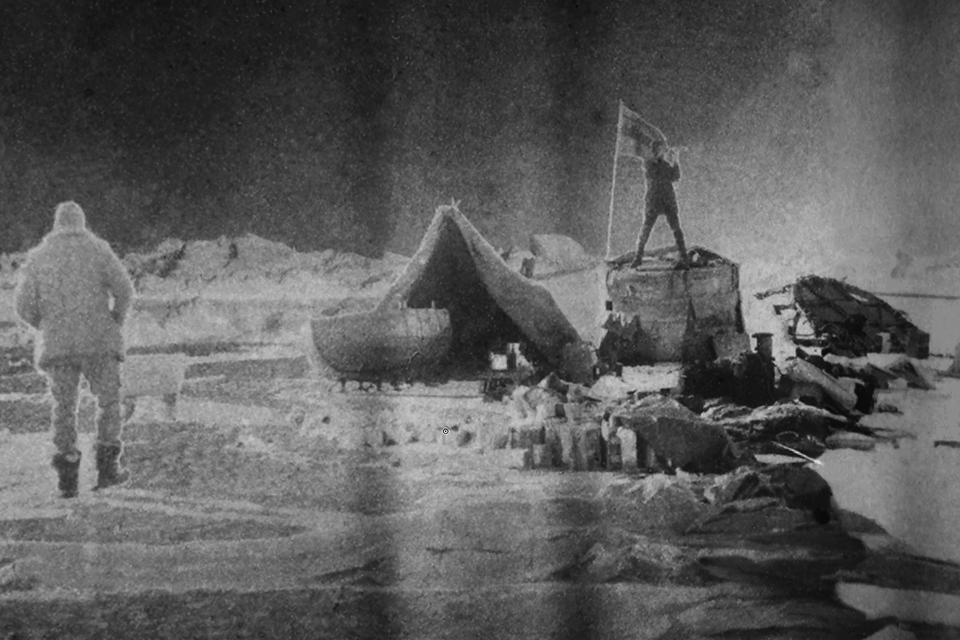
The bodies of Strindberg and Fraenkel were discovered not far away. Researchers concluded that the trio had likely succumbed to cold and exhaustion rather than to sickness or starvation. Also found nearby were diaries, letters, almanacs, undeveloped film and logbooks, detailing their ordeal.
Svenksund, the same gunboat that had accompanied Andrée’s expedition north to Danes Island more than three decades earlier, arrived in Stockholm with the bodies on October 5, 1930. Oscar II had long since died, but three coffins were placed on the dock at the feet of his son, King Gustaf V, who stood at attention while guns fired a salute and every bell rang in the city. Despite pelting rain, tens of thousands of Swedes joined in a procession to the city’s Great Church, St. Nicholas.
Archbishop Nathan Söderblom presided at the state funeral. “Welcome home!” he thundered from the pulpit. “Welcome, Strindberg! Welcome, Fraenkel! Welcome, Andrée! You have been many years away. And what we now receive are merely the ruins of magnificent, well-tempered instruments fitted for indomitable longing and clear-sighted achievement.”
C. Michael Hiam is the author of Dirigible Dreams: The Age of the Airship. Also see Andrée’s Story: The Complete Record of his Polar Flight, by S.A. Andrée, Nils Strindberg and Knut Fraenkel.
Originally published in the March 2014 issue of Aviation History. To subscribe, click here.

